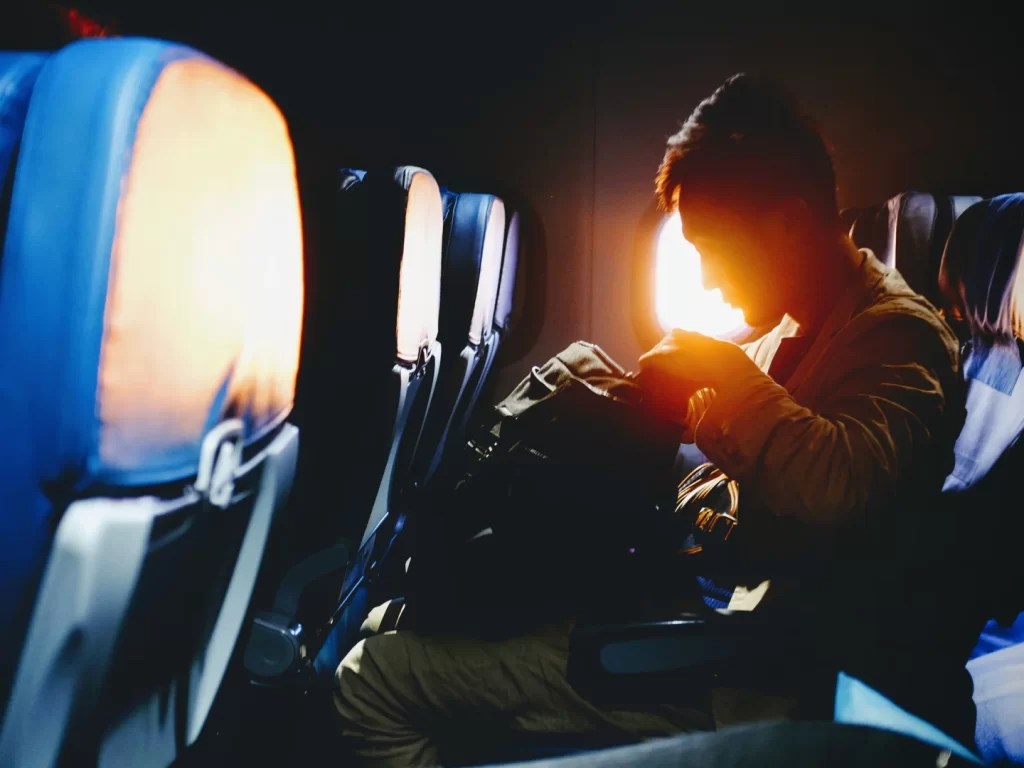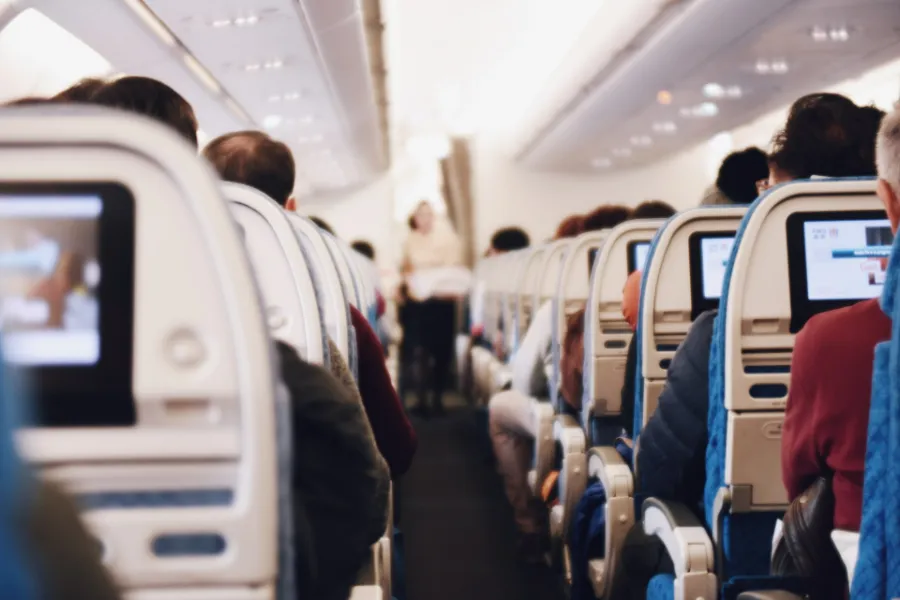Many people find camping and traveling fascinating activities, but to be into it makes your vacation rather difficult as it seems to be. This article provides you with useful tips on how to fly with camping gear to make your journey not stressful, but exciting.

How to choose the way of traveling?
You have to decide how you would reach the camping destination and bring all the necessary things with you. Of course, it depends on how far you want to travel.
The easiest way to transport all camping gear is to travel by car. However, there are lots of places you cannot reach this way. And some airlines have very strict rules when it comes to luggage.
To explore more exotic or long-distance lands, you have to follow some instructions. Let’s take a look at some advice given to make sure you won’t have any problem traveling around the world.
How to pack light and smart?
Can I bring a camping backpack on a plane?
Yes, however, the size of it matters. That’s why you should save space and pack smart.
Consider carefully what you need for your camping trip. It’s even better to make a list of all the necessary things. You can also think of things you need to bring and things you can buy/rent once you get there.
Packing tips
- Pack things in the order you’re going to use them. It’ll help to stay organized throughout your trip.
- Choose clothes made of light, natural fabrics that won’t absorb sweat and odors, so you can wear them more than once.
- You don’t need to pack food if you can get it at a local store near your campground.
- Find out if that’s an option to rent camping gear, so you don’t even have to take it with you.
- Think of the items you can share with people you are going on a trip with.
- Make sure that you have everything you need for a safe and fun adventure, while not adding anything you don’t need.

How to take less space?
Not only does the number of things you bring matter, but also the size of camping gear and your bag. So, you should think of the most efficient hacks to save space.
Compact packaging tips
- Use a smaller tent and a sleeping bag. It would not only take less space but also have less weight.
- Choose camping gear that is specifically designed for backpacking, it’ll generally be lighter and smaller.
- Try to use things for several purposes. For example, your sleeping bag can double as a blanket and a sleeping pad as a chair.
- Compression sacks and packing cubes can also be a solution for space-saving.
- Unless you’re backpacking, you can use a large duffel to fit in bulky items like sleeping bags and tents.
How to fly with camping gear?
Flying with camping gear is difficult, not only because of physical discomfort but also because of the airlines’ special restrictions on the luggage. Not all trips required gear that can easily fit in your backpack, that’s why you need to pay attention to the regulations concerning the transportation of your belongings.
Generally, there are weight and size limits for checked baggage. However, hand luggage typically doesn’t have weight restrictions, but the size matters. The standard size of a carry-on bag assures your luggage can fit into the overhead bin.
Tips on how to quickly pass security and easily get on a plane
Check your airline’s maximum allowed size and weight for your luggage.
Make sure to weigh and measure your bags to ensure they will fit the requirements for size and weight for your airline. You can buy luggage scales to weigh your bag before you get to the airport.
Check the airline’s website for information about the types of bags that are allowed.
Tips for measuring a bag
- Measure your bag when it’s been already packed.
- Measure the bag when it’s both zipped and unzipped if it opens up to extend the bag.
- The bag’s linear inches or centimeters are most useful, considering the various sizes and shapes they come in.
- The linear measurement is the height, length, and depth of your bag.
- When you get the bag’s linear measurement, don’t forget to include the wheels and handles, too.
How to protect a backpack?
Many people choose to check backpacks.
However, there is always a possibility of the straps getting hung and ripped on the luggage carousel. And to protect your backpack, you should tighten the shoulder straps as much as you can, and tie them together. This will prevent the baggage handler from grabbing just one strap.
You can also buckle the hip belt backward around the pack itself and secure the zippers, by tucking them under the hangover liner.
Finally, you can also wrap your backpack in plastic wrap for an extra layer of protection. Almost every airport provides a wrapping service.
To protect the things inside, make sure you wrap sharp objects, for this you can use plastic caps or even your towels. This not only ensures that the sharp tips won’t damage other stuff in your suitcase but also help you pass security.
And it’s even better to use hard-sided suitcases that provide the best protection against the rough handling of luggage during transport. So, you can pack gear in it as much as possible.

How not to lose a checked bag?
To quickly recognize your bag, you can wrap a vividly colored ribbon around the handle and take a photo of your backpack. This could also help the staff to find it in case it gets lost.
Checked bags are found easier if the owner leaves contact information. For example, you can put the backpack inside a large plastic bag to protect the straps from damage. Then make sure to put a label with your name, phone number, and email on the backpack inside the plastic bag.
Despite anything that could happen with your bag, it’s still a greater chance to get it back.
Do you need more than just a backpack?
A backpack may be an optimal solution for an outdoor adventure, but there are also lots of other options depending on your needs, way of traveling, and vacation conditions.
So, what to use instead?
- A large duffel bag. Instead of using hard shell bags, get a large duffel. It is lightweight, meets most airlines’ maximum allowed size for checked luggage, and folds up for easy storage. It is great for stowing gear and big enough for one traveler. A duffel bag can also be waterproofed or even have backpack straps that tuck away, so they can’t be damaged.
- A hard-sided suitcase. This kind of luggage would require a rental car or someplace to store it during your trip. Of course, it’s heavier than a duffel, but also more secure. A suitcase is less likely to be damaged during the trip, as are the things it contains.
- A cardboard box. You can pack camping gear in it. Also, make sure it doesn’t exceed the allowable size and dimensions. And don’t forget about weight restrictions. You can also use bubble wrap for such things as trekking poles, and tent stakes.
Also, there are a laundry bag and a heavy-duty trash bag. They are lightweight and fold up easily when not in use.

Flying with camping gear: airline regulations
Air travel is fast and convenient, but it also has its disadvantages. For example, there are many restrictions about what you can and cannot bring on a plane. The Transportation Security Administration (TSA) decides on these regulations. Before you head to the airport, you can always check TSA’s website to see whether you’re allowed to bring particular gear on board.
Never bring things you’re not prepared to give up because regardless of what the website might say, the TSA officer has the final say on whether an item is allowed or not. Rules can depend on the individual airlines, which can also have their regulations. That’s why you should do research, to know about peculiarities in advance.
When it comes to traveling by plane, there are usually so many questions… Can a tent be a carry-on? Are camping stoves allowed on planes? So, let’s figure it out.
What CAN’T you bring on a plane?
Generally, inflammable substances (aerosol, fuel, propane) are strictly prohibited. For example, bear spray. Pepper spray is not allowed either.
If you need bear spray, find out where you can purchase it at your destination before you leave. If you’re heading to a national park, you can check with rangers or your vacation rental host, hotel, or tour operator to find out if they have an extra one.
When there is time for you to leave, give your bear spray to someone in the area, it’s too expensive to throw it away.
According to the TSA, stove fuel isn’t allowed in checked or carry-on bags, but you can easily find camp stove fuel in camping areas. If you are going to a remote location, check in advance where you can purchase fuel for camping stoves.
However, you can bring a camping stove, if it’s clean and empty. And it’s even better to bring it in your carry-on bag because a camp stove can be easily bent or damaged in the tossing around of checked bags. TSA officers are also likely to inspect it.
Gas torches and torch lighter are not allowed in either carry-on or checked bags. Items considered flammable/combustible are forbidden on board.

What CAN you bring on a plane?
First of all, let’s answer some important questions.
Can you bring camping gear on a plane?
You are allowed to bring camping gear on board. But not everything can be carried in hand luggage.
Can you bring a camping tent on a plane?
Of course, you can, as well as sleeping bags. But it’s not lightweight gear and would take a lot of room in your bag.
Can you fly with tent pegs?
Yes, but as a sharp object, it should be in checked luggage, and properly protected.
Sharp objects are allowed in checked luggage, including knives and pocket knives, axes, large scissors, trekking poles, tent stakes, tent poles, hiking poles, etc. Any sharp item should be properly sheathed or wrapped so as not to injure baggage handlers.
You can have liquids in carry-ons if packed in containers less than 100ml/3.4oz. These include detergent, bug spray, sunscreen, water, etc. Although, in an aerosol spray container, they are forbidden. Perhaps, it’s better to get items like bug spray and sunscreen after arriving at your destination.
You are allowed to have disposable & zippo lights in both carry-on and checked bags. They have to be emptied if you want to put them into checked luggage. Lithium battery-powered lighters are allowed in carry-ons, but not in checked luggage.
You have to carry only one book of safety matches on a plane, not in your checked luggage.
According to the TSA, you can take cooked and frozen food and perishables on the flight.
You can have your medication in a carry-on bag. But don’t forget to inform the TSA officer about them.
Lithium batteries should be either in their original packaging or in the device they’re powering. They are allowed only in carry-on luggage.
Flashlights are allowed in both checked and hand luggage.

Alternatives to flying with camping gear
How do you transport camping gear? After figuring out how to fly with camping gear, you could think of other possible options to transport all the camping gear you need.
Renting camping gear
Renting saves you money and space. You don’t have to buy everything you want to use during your backpacking trip. You can try out new camping equipment to decide whether it’s worth buying or not. It’s also a good option when you are not sure that some expensive camping gear is essential.
If you want to pack light or make more room in your luggage, it’s better to rent. There are a lot of rental companies that provide you with their equipment for a certain fee.
Shipping camping gear
Also, you can have your outdoor gear shipped to almost any location. You don’t have to worry about TSA searches and repacking. And there are not so many restrictions either but don’t forget to check for any restrictions on what you can transport, like stove fuel, etc.
Don’t forget to ship your equipment promptly and ask someone or some organization to pick up your gear for you.
Taking an organized trip
Many organized tours and backpacking trips include all the camping gear and supplies you need. If you need stove fuel, bear spray, or other backpacking gear, don’t forget to ask about it when you book any kind of outdoor adventure through a tour operator.

Summing Up
It isn’t hard to pack your camping gear for your flight. Don’t forget to make a checklist. Think about what you need to bring. And protect your camping gear.
Check both TSA’s and your airline’s regulations on what you can bring. Measure and weigh your luggage to avoid additional fees.
There are also a few ways to travel and transport your camping gear besides flying. Renting or shipping could be more convenient for you.
Yes, at first sight, it seems like you have to worry about everything and feel stressed all the time during your trip. But it is nothing compared with the new experience and joy you have while traveling.
Have a fantastic camping trip and get a lot of positive emotions!
Read also: Do I Need To Ground My Generator When Camping – easy guidance for campers

My name is Olivia Kellison. I have been camping with friends and on my own for a long time. For me, camping is a great way to escape everyday life’s chaos. I started this blog because I have always had a passion for the great outdoors, and here I am gladly sharing what I know with other outdoor enthusiasts. It does not matter whether you are an experienced adventurer, or just planning your first trip, my blog will be of great help to you.

